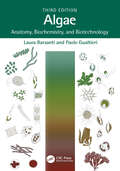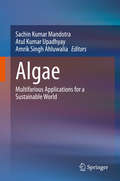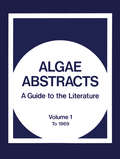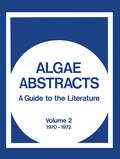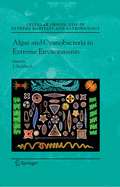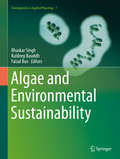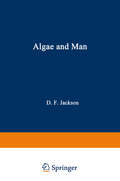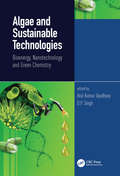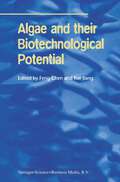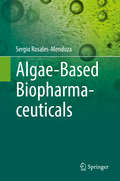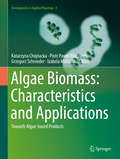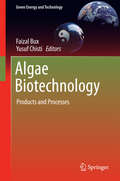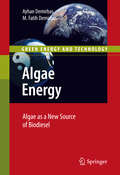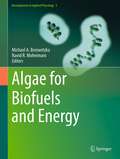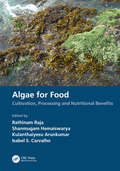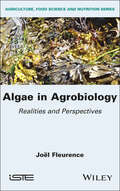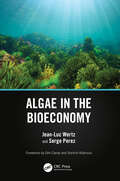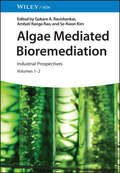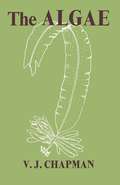- Table View
- List View
Algae: Anatomy, Biochemistry, and Biotechnology
by Laura Barsanti Paolo GualtieriA single-source reference on the biology of algae, the third edition of Algae: Anatomy, Biochemistry, and Biotechnology examines the most important taxa and structures for freshwater, marine, and terrestrial forms of algae. Its comprehensive coverage goes from algae's historical role through its taxonomy and ecology to its natural product possibilities. In this update, the authors have gathered a significant amount of new material, including: • more information on macroalgae • detailed description of biotic associations • updated description of biomass cultivation systems • coverage of different "omic" approaches and tools used in algal investigation • an expanded and updated algae utilization chapter The book's unifying theme is the important role of algae in the earth's self-regulating life support system and its function within restorative models of planetary health. It also discusses algae's biotechnological applications, including potential nutritional and pharmaceutical products. Written for students as well as researchers, teachers, and professionals in the field of phycology and applied phycology, this new full-color edition is both illuminating and inspiring.
Algae: Anatomy, Biochemistry, and Biotechnology
by Laura Barsanti Paolo GualtieriA single-source reference on the biology of algae, the third edition of Algae: Anatomy, Biochemistry, and Biotechnology examines the most important taxa and structures for freshwater, marine, and terrestrial forms of algae. Its comprehensive coverage goes from algae's historical role through its taxonomy and ecology to its natural product possibilities. In this update, the authors have gathered a significant amount of new material, including: • more information on macroalgae • detailed description of biotic associations • updated description of biomass cultivation systems • coverage of different "omic" approaches and tools used in algal investigation • an expanded and updated algae utilization chapter The book's unifying theme is the important role of algae in the earth's self-regulating life support system and its function within restorative models of planetary health. It also discusses algae's biotechnological applications, including potential nutritional and pharmaceutical products. Written for students as well as researchers, teachers, and professionals in the field of phycology and applied phycology, this new full-color edition is both illuminating and inspiring.
Algae: Multifarious Applications for a Sustainable World
by Sachin Kumar Mandotra Atul Kumar Upadhyay Amrik Singh AhluwaliaThis exciting book presents diverse applications of microalgal renewable resources to meet modern demands for energy and value-added products. It also comprehensively describes the role of algae in sustainable and cost-effective wastewater treatment strategies, and highlights the latest research on, advances in and biotechnological relevance of algae in the areas of bioenergy, bioremediation, pharmaceuticals, nutraceuticals and green economy. The book addresses gaps in the fields of bioenergy, waste management, health and economy by providing broad information on bioenergy production, management strategies, drug development, nutraceuticals products and biobased economy using algae at the commercial level. The book introduces researchers to key and emerging innovations in the field of algal biology research and will assist policymakers, environmentalists, scientists, students and global thinkers in defining sustainable developmental goals for the future. Accordingly, it is an extremely important read for researchers and students in the environmental sciences, life sciences and chemistry, experts in the energy sector and policymakers alike.
Algae Abstracts: A Guide to the Literature. Volume 1: To 1969
by Office Of Water Resources Research StaffAlgae Abstracts is the first in a series of bibliographies on water re sources and pollution published by IFI/ Plenum Data Corporation in cooperation with the Water Resources Scientific Information Center (WRSIC). It is produced wholly from the information base compris ing material abstracted and indexed for Selected Water Resources Abstracts. The bibliography is divided into volumes according to the publication dates of the source documents. Volume 1 contains 569 abstracts cov ering publication dates up to and including 1969; Volume 2 contains 730 abstracts covering the years 1970 to 1972. The material included in this bibliography represents computer selections based on the presence of a form of the word "alga" somewhere in the referenced citation. Substantively, the material typifies WRSIC's "centers of com petence" approach to information support of the Office of Water Re sources Research (OWRR) of the Department of the Interior. Most of the references in this bibliography are the work of the center of competence on eutrophication at the University of Wisconsin. The indexes refer to the WRSIC accession number, which follows each abstract. The Significant Descriptor Index is made up of a fraction of the total descriptors and identifiers by which each paper has been indexed. It represents weighted terms that best describe the informa tion content; this status is indicated by the asterisks which precede them. The General Index includes all the remaining descriptors and identifiers by which each paper in this bibliography has been indexed.
Algae Abstracts: A Guide to the Literature, Volume 2 1970–1972
by Office Of Water Resources Research StaffAigae Abstracts is the first in aseries of bibliographies on water re sources and pollution published by IFI/Plenum Data Corporation in cooperation with the Water Resources Scientific Information Center (WRSIC). It is produced wholly from the information base compris ing material abstracted and indexed for Selected Water Resources Abstracts. The bibliography is divided into volumes according to the publication dates of the source documents. Volume 1 contains 569 abstracts cov ering publication dates up to and including 1969; Volume 2 contains 730 abstracts covering the years 1970 to 1972. The material included in this bibliography represents computer selections based on the presence of a form of the word "alga" somewhere in the referenced citation. Substantively, the material typifies WRSIC's "centers of com petence" approach to information support of the Office of Water Re sources Research (OWRR) of the Department of the Interior. Most of the references in this bibliography are the work of the center of competence on eutrophication at the University of Wisconsin. The indexes refer to the WRSIC accession number, which follows each abstract. The Significant Descriptor Index is made up of a fraction of the total descriptors and identifiers by which each paper has been indexed. It represents weighted terms that best describe the informa tion content; this status is indicated by the asterisks which precede them. The General Index includes all the remaining descriptors and identifiers by which each paper in this bibliography has been indexed.
Algae and Cyanobacteria in Extreme Environments (Cellular Origin, Life in Extreme Habitats and Astrobiology #11)
by Joseph SeckbachThis collection of essays is devoted to algae that are unexpectedly found in harsh habitats. The authors explain how these algae thrive in various temperature ranges, extreme pH values, salt solutions, UV radiation, dryness, heavy metals, anaerobic niches, various levels of illumination, and hydrostatic pressure. Not only do the essays provide clues about life on the edges of the Earth, but possibly elsewhere in the universe as well.
Algae and Environmental Sustainability (Developments in Applied Phycology #7)
by Bhaskar Singh Kuldeep Bauddh Faizal BuxThis book presents the dynamic role of algae in a sustainable environment. Two major aspects, namely bioenergy and bioremediation, have been elaborated in various chapter contributed by scientists and teachers from different geographical areas throughout the world. Algal biofuels is an emerging area of equal interest to researchers, industries, and policy makers working or focusing on alternative (i.e. renewable) fuels. Algae have been an area of interest due to their wide range of applications. Over the last 5 decades, eukaryotic algae have been used in the aquaculture industry as feed for invertebrates, providing a rich source of antioxidants, dietary fiber, minerals and protein. More recently, there has been a focus on the use of algal biomass in the development of alternative fuels. The extraction of oil from algae has been widely explored as a much more viable feedstock than plant-based oils in large-scale fuel production. using algae as feedstock has the advantages that it doesn’t require arable land and that wastewater can be used as a source of nutrients in their culture. The multifunctional approach of algae includes pollution remediation, carbon sequestration, biofuels production, and delivery of value-added products. However, there are still some obstacles that need to be overcome to make their use as potential feedstock for biofuels techno-economically feasible. In order to maintain the sustainability aspect of algal biofuels, various aspects have to be studied and critically analyzed to assess the long-term sustainability of algal derived biofuels.This book discusses the role of algae as a promising future feedstock for biofuels. They are known to sequester carbon in much larger amounts than plants and as such the book also describes their phycoremediation potential for conventional as well as emerging contaminants. It describes the role of anaerobic digestion in algal biorefineries; bioreactions and process parameters; biogas recovery and reuse. The role of algal biofilm based technology in wastewater treatment and transforming waste into bio-products is discussed, and remediation of sewage water through algae is assessed. The book also describes the production of biohydrogen, bio-oil, biodiesel; and the major bottlenecks in their usage. The emerging characterization techniques of these biofuels (bio-oil and biodiesel) are described, as are the decolorizing potential of algae and the genetic engineering techniques that could enhance the production of lipids in algae. Other aspects of the book include the role of remote sensing technology in the monitoring of algae and a life cycle assessment of algal biofuels.
Algae and Man: Based on lectures presented at the NATO Advanced Study Institute July 22 – August 11, 1962 Louisville, Kentucky
by Daniel F. JacksonWith the continuous increase in human population and its constant demands on the aquatic environment, there has been a compounding of the interrelationships between algae and man. These relatively simple green plants not too long ago were often considered as merely biological curiosities. Within the past twenty-five years, with advances in technology and the increased eutrophication of lakes and streams, the interplay between algae and man has become more complex and more im portant. Problems of taste, odor, toxicity, or obnoxious growth caused by algae are unfortunately quite familiar to the water supplier and to the public health worker. Algae have met their role in the space age as a possible source for food or as a gas ex changer. In order to explore any of these practical problems, it is essential to have adequate, basic knowledge of algal taxonomy, physiology, cytogenetics and ecology. This book is the outgrowth of a North Atlantic Treaty Organi zation Advanced Study Institute in which authorities in both the applied and basic fields of phycology, as well as in cognate disci plines, met and discussed various topics related to algae. It is of significance to note that this was the first NATO Advanced Study Institute to be held in the United States and that it had for its theme a subject which is of import for the welfare of all mankind.
Algae and Sustainable Technologies: Bioenergy, Nanotechnology and Green Chemistry
by Atul Kumar Upadhyay D. P. SinghAlgal and sustainable technologies: Bioenergy, Nannotechnology and Green chemistry is an interdisciplinary overview of the world’s major problems; water scarcity, clean environment and energy and their sustenance remedy measures using microalgae. It comprehensively presents the way to tackle the socio-economic issues including food, feed, fuel, medicine and health and also entails the untapped potential of microalgae in environmental management, bioenergy solution and sustainable synthesis of pharmaceutical and nutraceutical products. This book basically emphasizes the success of algae as wonderful feed stocks of future and provides upto date information and sustainable and recreational outlook towards degrading environment and energy crisis. Applicability of fast emerging algae based nanotechnology in bioremediation and production of nanoparticle (AuNP, AgNP etc) are beautifully described along with latest research and findings. Key features: The "waste to best to income" strategies are the main concern of the book and take the edge off the problem of pollution, energy and income. Elucidate the sustainable phycoremediation and nanoparticle functions as low cost approach for various ecosystem services. Information regarding pharmaceuticals, nutraceuticals and other algae based value added product synthesis and fate are comprehensively discussed. Knowledge resource, latest research, findings and prospects presented in an accessible manner for researchers, students, eminent scientists, entrepreneurs, professionals and policy maker.
Algae and Sustainable Technologies: Bioenergy, Nanotechnology and Green Chemistry
by Atul Kumar Upadhyay D. P. SinghAlgal and sustainable technologies: Bioenergy, Nannotechnology and Green chemistry is an interdisciplinary overview of the world’s major problems; water scarcity, clean environment and energy and their sustenance remedy measures using microalgae. It comprehensively presents the way to tackle the socio-economic issues including food, feed, fuel, medicine and health and also entails the untapped potential of microalgae in environmental management, bioenergy solution and sustainable synthesis of pharmaceutical and nutraceutical products. This book basically emphasizes the success of algae as wonderful feed stocks of future and provides upto date information and sustainable and recreational outlook towards degrading environment and energy crisis. Applicability of fast emerging algae based nanotechnology in bioremediation and production of nanoparticle (AuNP, AgNP etc) are beautifully described along with latest research and findings. Key features: The "waste to best to income" strategies are the main concern of the book and take the edge off the problem of pollution, energy and income. Elucidate the sustainable phycoremediation and nanoparticle functions as low cost approach for various ecosystem services. Information regarding pharmaceuticals, nutraceuticals and other algae based value added product synthesis and fate are comprehensively discussed. Knowledge resource, latest research, findings and prospects presented in an accessible manner for researchers, students, eminent scientists, entrepreneurs, professionals and policy maker.
Algae and their Biotechnological Potential
by Feng Feng Chen Yue Yue JiangAlgae are important organisms that include seaweeds and a number of single-celled and multicellular microscopic forms. Algae are ubiquitous; they inhabit almost everywhere including oceans, freshwater bodies, rocks, soils, and trees. Man's uses of algae may date back to ancient times. In recent decades, there has been renewed interest in the utilization of algae as sources of health food and high-value chemicals and pharmaceuticals, and for aquaculture, agriculture, and wastewater treatment. Nevertheless, the biotechnological potential of algae is still far from fully exploited, due to a lack of understanding of algal characteristics and culture systems, as well as of advanced research techniques. This book contains selected papers presented at the Fourth Asia-Pacific Conference on Algal Biotechnology held in Hong Kong, on 3-6 July, 2000. Written by experts in the field, this book provides a state-of-the-art account of algal biotechnology research. Topics range from use of algae in agriculture to environmental monitoring and protection, from algal culture systems to production of high-value chemicals and pharmaceuticals by algae, and from algal product purification to gene transformation and regulations. This book is intended for use by researchers and industrialists in the field of algal biotechnology. It will also be an important reference for undergraduate and postgraduate students in biotechnology and food science, as well as in biology in general.
Algae-Based Biopharmaceuticals
by Sergio Rosales-MendozaThis book constitutes a key reference on the use of algae in the biopharmaceuticals production field; providing an updated outlook on the achievements accomplished thus far and transmitting a prospective view for this biotechnological application.This book provides a detailed description of the technology as well as an updated outlook of the strides achieved thus far in the field of algae-based biopharmaceuticals. Algae constitute attractive expression hosts for the production of recombinant proteins with medical applications. Among the features that make them attractive candidates are: low cost, fast growth, wide biosynthetic capacity, and absence of human pathogens; which constitute substantial advantages with respect to bacterial and mammalian systems. First, the features of algae as convenient hosts for the production of BFs are analyzed in terms of production costs, biosynthetic capacity, and safety (Chapter 1). Second, the genetic engineering tools for algae-species are described. Nuclear and chloroplast-based expression approaches are analyzed and compared in terms of biosynthetic advantages, gene expression complexity, and DNA transfer approaches (Chapter 2). In the following sections, chapters 3 to 7, the state of the art on producing distinct types of BFs in algae species is presented. Although this book is mainly focused on BFs, considering that the production of compounds with health-promoting properties are achieved using genetically-engineered algae strains, chapter 8 deals with nutraceuticals. In the ninth chapter, the developments reported thus far are placed in perspective and challenges for the field are discussed. Critical future prospects comprise the following: optimizing large-scale production in bioreactors, implementing glycoengineering approaches, optimizing nuclear expression, exploring new approaches for oral delivery, and implementing regulatory frameworks to accomplish technology transfer and regulatory approval of algae-made BFs.
Algae Biomass: Towards Algae-based Products (Developments in Applied Phycology #8)
by Katarzyna Chojnacka Piotr Pawel Wieczorek Grzegorz Schroeder Izabela MichalakThis book is a compendium of knowledge on the useful properties of algae in the context of application as a useful component of innovative natural products. It presents all aspects of industrial applications of macroalgae biomass derived from the natural environment. Despite many interesting characteristics, algae are still regarded as undervalued raw material, therefore, present in the following chapters are not only environmental benefits arising from the development of excessive algal biomass, but also the distribution and biology of algae in natural conditions in reservoirs, methods of obtaining extracts from biomass of algae for industrial purposes. Furthermore, it also includes topics such as the use of biomass and algae extracts for the industrial purposes, in animal breeding and for agricultural purposes, as well as the economic aspects of algae biomass harvesting for industrial purposes. The book is intended for a wide audience interested in new methods of obtaining the biomass from the natural environment for industrial purposes and the manufacture of products based on bioactive substances obtained from the environment.
Algae Biotechnology: Products and Processes (Green Energy and Technology)
by Faizal Bux Yusuf ChistiThis book examines the utilization of algae for the development of useful products and processes with the emphasis towards green technologies and processes, and the requirements to make these viable. Serving as a complete reference guide to the production of biofuels and other value added products from micro and macro algae, it covers various aspects of algal biotechnology from the basics to large scale cultivation, harvesting and processing for a variety of products. It is authored and edited by respected world experts in the field of algal biotechnology and provides the most up to date and cutting edge information on developments in the field. Over the past decade there has been substantial focus and related literature on the application of algal biomass for the generation of novel processes and products. ‘Algae Biotechnology: Products and Processes’ encompasses a holistic approach to critically evaluating developments in the field of algal biotechnology whilst taking into account recent advances and building on the body of knowledge. Aspects of the effects of harmful algae are also discussed, as well as the potential commercial application of algal biotechnology, the techno-economic feasibility of algal biodiesel production and the use of genetic and metabolic engineering for the improvement of yield. Other bioenergy sources such as alcohol fuels, aviation fuels, biohydrogen and biogas are also covered. This book is intended for postgraduates and researchers working in the biofuels and algal industry; it constitutes ideal reference material for both early stage and established researchers.
Algae Energy: Algae as a New Source of Biodiesel (Green Energy and Technology)
by Ayhan Demirbas Muhammet Fatih DemirbasAlgae Energy covers the production of algae culture and the usage of algal biomass conversion products. It also reviews modern biomass-based transportation fuels, including biodiesel, bio-oil, biomethane and biohydrogen. Each chapter opens with fundamental explanations suitable for those with a general interest in algae energy and goes on to provide in-depth scientific details for more expert readers. Algae energy is discussed within the wider context of green energy, with chapters covering topics such as: green energy facilities, algae technology, energy from algae and biodiesel from algae. Algae Energy addresses the needs of energy researchers, chemical engineers, fuel and environmental engineers, postgraduate and advanced undergraduate students, and others interested in a practical tool for pursuing their interest in bio-energy.
Algae for Biofuels and Energy (Developments in Applied Phycology #5)
by Michael A. Borowitzka and Navid R. MoheimaniMicroalgae are one of the most studied potential sources of biofuels and bioenergy. This book covers the key steps in the production of renewable biofuels from microalgae - strain selection, culture systems, inorganic carbon utilisation, lipid metabolism and quality, hydrogen production, genetic engineering, biomass harvesting, extraction. Greenhouse gas and techno-economic modelling are reviewed as is the 100 year history of microalgae as sources of biofuels and of commercial-scale microalgae culture. A summary of relevant basic standard methods used in the study of microalgae culture is provided. The book is intended for the expert and those starting work in the field.
Algae for Food: Cultivation, Processing and Nutritional Benefits
by Rathinam Raja Shanmugam Hemaiswarya Kulanthaiyesu Arunkumar Isabel S. CarvalhoAlgae for Food: Cultivation, Processing and Nutritional Benefits Algae are a primitive, living photosynthetic form and they are the oldest living organism. In the marine ecosystem, algae are the primary producers that supply energy required to a diverse marine organism and especially seaweed provides a habitat for invertebrates and fishes. There have been significant advances in many areas of phycology. This book describes the advances related to food and nutrition of algae achieved during the last decades, it also identifies gaps in the present knowledge and needs for the future. The 17 chapters, grouped into 6 parts, are written by phycologists. More insight on industrial exploitation of algae and their products is supported by current studies and will help academia. The first part explains new technologies to improve the microalgal biomass, strain improvement and different methods of seaweed cultivation. In the second part, food and nutraceutical applications of algae, food safety aspects, green nanotechnology and formulation methods for the extraction and isolation of algal functional foods are described. The third part deals with pigments and carotenoids while the fourth part exploits the isolation and application of hydrocolloids, nutritional implications of algal polysaccharides and the characterization and bioactivity of fucoidans. In the fifth part, the biomedical potential of seaweed followed by agricultural applications of algae are well described. The book is an important resource for scholars that provides knowledge on wide range of topics. Key Features Covers important fields of algae from biomass production to genetic engineering aspects of algae Useful in the field of algal biotechnology, aquaculture, marine micro and macrobiology, microbial biotechnology and bioprocess technology Focuses on the therapeutic and nutritional areas of algae
Algae for Food: Cultivation, Processing and Nutritional Benefits
by Rathinam Raja Shanmugam Hemaiswarya Kulanthaiyesu Arunkumar Isabel S. CarvalhoAlgae for Food: Cultivation, Processing and Nutritional Benefits Algae are a primitive, living photosynthetic form and they are the oldest living organism. In the marine ecosystem, algae are the primary producers that supply energy required to a diverse marine organism and especially seaweed provides a habitat for invertebrates and fishes. There have been significant advances in many areas of phycology. This book describes the advances related to food and nutrition of algae achieved during the last decades, it also identifies gaps in the present knowledge and needs for the future. The 17 chapters, grouped into 6 parts, are written by phycologists. More insight on industrial exploitation of algae and their products is supported by current studies and will help academia. The first part explains new technologies to improve the microalgal biomass, strain improvement and different methods of seaweed cultivation. In the second part, food and nutraceutical applications of algae, food safety aspects, green nanotechnology and formulation methods for the extraction and isolation of algal functional foods are described. The third part deals with pigments and carotenoids while the fourth part exploits the isolation and application of hydrocolloids, nutritional implications of algal polysaccharides and the characterization and bioactivity of fucoidans. In the fifth part, the biomedical potential of seaweed followed by agricultural applications of algae are well described. The book is an important resource for scholars that provides knowledge on wide range of topics. Key Features Covers important fields of algae from biomass production to genetic engineering aspects of algae Useful in the field of algal biotechnology, aquaculture, marine micro and macrobiology, microbial biotechnology and bioprocess technology Focuses on the therapeutic and nutritional areas of algae
Algae in Agrobiology: Realities and Perspectives
by Joel FleurenceAlgae, macroalgae and microalgae can be valuable biological resources in a new, more environmentally friendly form of agriculture known as agrobiology. Indeed, the biological properties associated with algae are frequently relevant for agricultural and zootechnical purposes. It is this aspect that is behind the current popularity of algae in the development of new agricultural practices that are related to plant and animal production, which are referred to as agrobiology. Algae in Agrobiology offers a current and forward-looking account of algae use: in agriculture and in the sector of land and marine animal production, as algal extracts and molecules in the form of fertilizers or biostimulants for crops with agronomic interest, and as algal compounds in the area of plant and animal health. This book is based on advances in biochemical and agronomic research in order to explain the conventional practices associated with the use of algae in agriculture and livestock breeding. These advances make it possible to establish possible uses for marine algal resources in the agriculture of the future.
Algae in Agrobiology: Realities and Perspectives
by Joel FleurenceAlgae, macroalgae and microalgae can be valuable biological resources in a new, more environmentally friendly form of agriculture known as agrobiology. Indeed, the biological properties associated with algae are frequently relevant for agricultural and zootechnical purposes. It is this aspect that is behind the current popularity of algae in the development of new agricultural practices that are related to plant and animal production, which are referred to as agrobiology. Algae in Agrobiology offers a current and forward-looking account of algae use: in agriculture and in the sector of land and marine animal production, as algal extracts and molecules in the form of fertilizers or biostimulants for crops with agronomic interest, and as algal compounds in the area of plant and animal health. This book is based on advances in biochemical and agronomic research in order to explain the conventional practices associated with the use of algae in agriculture and livestock breeding. These advances make it possible to establish possible uses for marine algal resources in the agriculture of the future.
Algae in the Bioeconomy
by Jean-Luc Wertz Serge PerezAlgae play an important ecological role as oxygen producers and carbon sequesters and are the food base for all aquatic life. Algae are economically important as a source of crude oil, food and feed, and pharmaceutical and industrial products. High-value and sustainable products from algae are already economically viable and can be a fundamental driver for fuel production. Algae in the Bioeconomy provides a detailed overview of the chemical composition of algae and shows that an integrated biorefinery approach is necessary for large-scale algae production and conversion, where multiple products are produced. This book serves as a unique compendium of knowledge covering the essential features of algae and their applications. Discusses the structural chemistry and biology of micro- and macroalgal components Describes classification, occurrence, conversion, and production of micro- and macroalgae Offers strategies for optimal use of micro- and macroalgae in the bioeconomy, including regional strategies in the EU, US, China, India, Malaysia, Norway, and Chile Features forewords from international experts offering both a scientific and an economic/strategic viewpoint This book is intended for an interdisciplinary audience in chemical engineering, biotechnology, and environmental science and engineering, promoting research, development, and application of algae as a sustainable resource.
Algae in the Bioeconomy
by Jean-Luc Wertz Serge PerezAlgae play an important ecological role as oxygen producers and carbon sequesters and are the food base for all aquatic life. Algae are economically important as a source of crude oil, food and feed, and pharmaceutical and industrial products. High-value and sustainable products from algae are already economically viable and can be a fundamental driver for fuel production. Algae in the Bioeconomy provides a detailed overview of the chemical composition of algae and shows that an integrated biorefinery approach is necessary for large-scale algae production and conversion, where multiple products are produced. This book serves as a unique compendium of knowledge covering the essential features of algae and their applications. Discusses the structural chemistry and biology of micro- and macroalgal components Describes classification, occurrence, conversion, and production of micro- and macroalgae Offers strategies for optimal use of micro- and macroalgae in the bioeconomy, including regional strategies in the EU, US, China, India, Malaysia, Norway, and Chile Features forewords from international experts offering both a scientific and an economic/strategic viewpoint This book is intended for an interdisciplinary audience in chemical engineering, biotechnology, and environmental science and engineering, promoting research, development, and application of algae as a sustainable resource.
Algae Mediated Bioremediation: Industrial Prospectives, 2 Volumes
by G. A. Ravishankar A. Ranga Rao Se-Kwon KimAlgae Mediated Bioremediation Develop new methods for remediating pollution with this cutting-edge guide In a world where environmental remediation and pollution removal are becoming more critical with every passing day, the search for organic and sustainable solutions has never been more critical. Removing organic pollutants through the use of algae has become an especially promising avenue for bioremediation, with a far lower environmental impact than comparable mechanical, physical, or chemical approaches. The possibility of deriving bioenergy from the resulting biomass makes this approach even more potentially critical to a sustainable future. Algae Mediated Bioremediation offers a cutting-edge overview of these processes and their applications. Its comprehensive approach to the problems of pollution abatement and the value of algae as environmental and biotechnological agents include both practical solutions and key gaps in existing research. Algae Mediated Bioremediation readers will also find: Case studies of successful use drawn from across the globe Detailed discussion of remediating aquatic, atmospheric, and terrestrial habitats Applications for value-added products incorporating biomass Algae Mediated Bioremediation is ideal for biotechnologists, biochemists, natural products chemists, and other researchers working in industry or environmental research.
Algae Mediated Bioremediation: Industrial Prospectives, Volumes 1 - 2
by Gokare A. Ravishankar Ambati Ranga Rao, Se-Kwon Kim Se-Kwon KimAlgae Mediated Bioremediation Develop new methods for remediating pollution with this cutting-edge guide In a world where environmental remediation and pollution removal are becoming more critical with every passing day, the search for organic and sustainable solutions has never been more critical. Removing organic pollutants through the use of algae has become an especially promising avenue for bioremediation, with a far lower environmental impact than comparable mechanical, physical, or chemical approaches. The possibility of deriving bioenergy from the resulting biomass makes this approach even more potentially critical to a sustainable future. Algae Mediated Bioremediation offers a cutting-edge overview of these processes and their applications. Its comprehensive approach to the problems of pollution abatement and the value of algae as environmental and biotechnological agents include both practical solutions and key gaps in existing research. Algae Mediated Bioremediation readers will also find: Case studies of successful use drawn from across the globe Detailed discussion of remediating aquatic, atmospheric, and terrestrial habitats Applications for value-added products incorporating biomass Algae Mediated Bioremediation is ideal for biotechnologists, biochemists, natural products chemists, and other researchers working in industry or environmental research.
